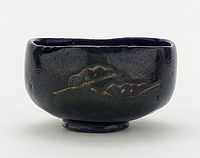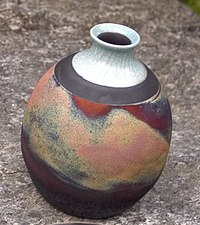Raku ware: Difference between revisions
Added °C as we are in the C21st |
Cagedcalcium (talk | contribs) mNo edit summary |
||
| Line 7: | Line 7: | ||
The term ''raku'' is derived from the site where clay was dug in Kyoto in the late 16th century and is found in the [[Kanji]] character meaning "enjoyment" or "ease." For 15 generations it has been the title and seal used by a lineage of potters whose work formed the central tradition in Japan. This lineage believes that 'raku' refers to the potters who use the technique, not the technique itself. |
The term ''raku'' is derived from the site where clay was dug in Kyoto in the late 16th century and is found in the [[Kanji]] character meaning "enjoyment" or "ease." For 15 generations it has been the title and seal used by a lineage of potters whose work formed the central tradition in Japan. This lineage believes that 'raku' refers to the potters who use the technique, not the technique itself. |
||
In the [[16th century]], the first of these potters, [[Chōjirō]] is said to have come under the patronage of the Japanese tea master [[Sen-No-Rikyu]]. According to legend, in 1598, the ruler [[Hideyoshi]], after Chōjirō's death in 1592, bestowed upon his adopted son, Jōkei, a golden seal with the written symbol "raku." Both the name and the ceramic style have been passed down through the family to the present. After the publication of a manual in the 18th century, raku ware was also made by numerous workshops in and around Kyoto: by amateur potter tea practitioners and by professional and amateur potters around Japan. |
In the [[16th century]], the first of these potters, [[Chōjirō]] is said to have come under the patronage of the Japanese tea master [[Sen-No-Rikyu]]. According to legend, in 1598, the ruler [[Hideyoshi]], after Chōjirō's death in 1592, bestowed upon his adopted son, Jōkei, a golden seal with the written symbol "raku." Both the name and the ceramic style have been passed down through the family (sometimes by adoption) to the present 15th generation (Kichizaemon). After the publication of a manual in the 18th century, raku ware was also made by numerous workshops in and around Kyoto: by amateur potter tea practitioners and by professional and amateur potters around Japan. |
||
Raku ware marked an important point in the historical development of Japanese ceramics, as it is the first ware to use a seal mark and the first to focus on close collaboration between potter and patron. Other famous Japanese clay artists of this period include Dōnyū (grandson of Chōjirō, also known as Nonkō; 1574-1656), [[Honami Kōetsu|Hon'ami Kōetsu]] (1556-1637) and [[Ogata Kenzan]] (1663-1743). |
Raku ware marked an important point in the historical development of Japanese ceramics, as it is the first ware to use a seal mark and the first to focus on close collaboration between potter and patron. Other famous Japanese clay artists of this period include Dōnyū (grandson of Chōjirō, also known as Nonkō; 1574-1656), [[Honami Kōetsu|Hon'ami Kōetsu]] (1556-1637) and [[Ogata Kenzan]] (1663-1743). |
||
Revision as of 14:36, 10 December 2008


Rakuyaki (楽焼), or Raku ware, is a form of Japanese pottery characterized by low firing temperatures (resulting in a fairly porous body), lead glazes, and the removal of pieces from the kiln while still glowing hot. In the traditional Japanese firing process, the pot is removed from the hot kiln and put directly into water or allowed to cool in the open air. Raku is considered the traditional method for creating bowls for the Japanese tea ceremony. Raku tea bowls are hand-made from earthenware, each with a unique shape and style. Raku techniques have been adopted and modified by contemporary potters worldwide.
Japanese raku
The term raku is derived from the site where clay was dug in Kyoto in the late 16th century and is found in the Kanji character meaning "enjoyment" or "ease." For 15 generations it has been the title and seal used by a lineage of potters whose work formed the central tradition in Japan. This lineage believes that 'raku' refers to the potters who use the technique, not the technique itself.
In the 16th century, the first of these potters, Chōjirō is said to have come under the patronage of the Japanese tea master Sen-No-Rikyu. According to legend, in 1598, the ruler Hideyoshi, after Chōjirō's death in 1592, bestowed upon his adopted son, Jōkei, a golden seal with the written symbol "raku." Both the name and the ceramic style have been passed down through the family (sometimes by adoption) to the present 15th generation (Kichizaemon). After the publication of a manual in the 18th century, raku ware was also made by numerous workshops in and around Kyoto: by amateur potter tea practitioners and by professional and amateur potters around Japan.
Raku ware marked an important point in the historical development of Japanese ceramics, as it is the first ware to use a seal mark and the first to focus on close collaboration between potter and patron. Other famous Japanese clay artists of this period include Dōnyū (grandson of Chōjirō, also known as Nonkō; 1574-1656), Hon'ami Kōetsu (1556-1637) and Ogata Kenzan (1663-1743).
Western raku techniques

The use of a reduction chamber at the end of the raku firing was introduced by the American potter Paul Soldner in the 1960s to compensate for the difference in atmosphere between wood-fired Japanese raku kilns and gas-fired American kilns. Typically, pieces removed from the hot kiln are placed in masses of combustible material (e.g., straw, sawdust, or newspaper) to provide a reducing atmosphere for the glaze and to stain the exposed body surface with carbon.
Western raku potters rarely use lead as a glaze ingredient, due to its serious level of toxicity. Japanese potters substitute a non-lead frit. Although almost any low-fire glaze can be used, potters often use specially formulated glaze recipes that "crackle" or craze (present a cracked appearance), because the crazing lines take on a dark color from the carbon.
Western raku is typically made from a stoneware clay body and are bisque fired at 900°C (1650°F) and glaze fired (the final firing) between 800-1000°C (1450-1800°F), which falls into the cone 06 firing temperature range. The process is known for its unpredictability, particularly when reduction is forced, and pieces may crack or even explode due to thermal shock. Pots may be returned to the kiln to re-oxidize if firing results do not meet the potter's expectations, although each successive firing has a high chance of weakening the overall structural integrity of the pot. Pots that are exposed to thermal shock multiple times can break apart in the kiln, as they are removed from the kiln, or when they are in the reduction chamber.
The glaze firing times for raku ware are short: an hour or two as opposed to up to 16 hours for high-temperature cone 10 stoneware firings. This is due to several factors: raku glazes mature at a much lower temperaturee (under 980°C/1800°F, as opposed to almost 1260°C/2300°F for high-fire stoneware), kiln temperatures can be raised rapidly, and the kiln is loaded and unloaded while hot and can be kept hot between firings.
Because temperature changes are rapid during the raku process, clay bodies used for raku ware must be able to cope with significant thermal stress. The usual way to deal with this is to incorporate a high percentage of quartz, grog, or kyanite into the body before the pot is formed. Each is used to add strength to the clay body and to reduce thermal expansion. When used at high additions, quartz can increase the risk of dunting or shivering therefore, kyanite is often the preferred material because it contributes both mechanical strength and, in amounts up to 20%, it significantly reduces thermal expansion. Although any clay body can be used, most porcelains and white stoneware clay bodies are unsuitable for the western raku process unless some material is added to deal with thermal shock.
Aesthetic considerations include clay color and fired surface texture, as well as the clay's chemical interaction with raku glazes.
In a craft conference in Kyoto in 1979, a heated debate sprang up between Western raku artists Paul Soldner and Rick Hirsh and the youngest in the dynastic raku succession, Kichiemon, (Part of the fourteenth generation of the "Raku" family of potters.) concerning the right to use the title 'raku'. The Japanese artists maintain that any work by other craftsman should hold their own name, (i.e. Soldner-ware, Hirsh-ware), as that was how 'raku' was intended.
References
- Pitelka, Morgan. Handmade Culture: Raku Potters, Patrons, and Tea Practitioners in Japan. University of Hawaii Press, 2005. ISBN 0-8248-2970-0.
- Hamer, Frank and Janet. The Potter's Dictionary of Materials and Techniques. A & C Black Publishers, Limited, London, England, Third Edition 1991. ISBN 0-8122-3112-0.
- Peterson, Susan. The Craft and Art of Clay. The Overlook Press, Woodstock, NY, Second Edition 1996. ISBN 0-87951-634-8.
